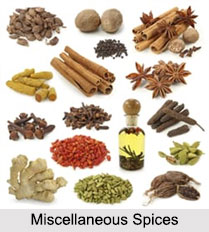 Miscellaneous Spices are the various spices that do not come under any category of seed, fruit and others but yet belong to the family of spices. Spices are distinguished from herbs, which are the leaves, flowers or stems from plants used for flavouring or as a garnish. Miscellaneous spices are used to impart flavour and taste to the food. Some common miscellaneous spices include amchur, camphor, arrowroot and others.
Miscellaneous Spices are the various spices that do not come under any category of seed, fruit and others but yet belong to the family of spices. Spices are distinguished from herbs, which are the leaves, flowers or stems from plants used for flavouring or as a garnish. Miscellaneous spices are used to impart flavour and taste to the food. Some common miscellaneous spices include amchur, camphor, arrowroot and others.
Amchur
Amchur is not a product of ripe mango. It is the dried or dehydrated product prepared from unripe mango flesh in the form of peeled slices or powder used for acidification of curries etc. Invariably under-ripe and wind fallen seedlings or country mangoes are utilized for the manufacture of Amchur. Amchur is one of the important miscellaneous spices that are produced mostly in the northern states of India.
Camphor
Camphor or Karpoor is well known miscellaneous spice, known for its aroma. In fact it is well known all over the world and is part of various religious and social rituals in entire Oriental world. Camphor has been used for many centuries as a culinary spice, a component of incense and as a medicine. It is also an insect repellent and a flea-killing substance.
Arrowroot
Arrowroot is also known as tapioca flour and can be used as a thickening agent for sauces, pudding, pie fillings and gravies. Unlike cornstarch, it doesn"t have a chalky taste when undercooked. Arrowroot is tasteless and becomes clear when cooked. It has the unique characteristic of adding a glossy sheen to the food.
Asafoetida
Asafoetida is also known as Hing, this is a crucial ingredient in Indian cooking especially vegetarian dishes. It has a unique smell and flavour, unpleasantly strong while raw but mellow and garlic type when cooked. It adds a strong pungent smell and mysterious flavour to dishes.
The miscellaneous spices are used in various dishes all across India. With different climates in different parts of the country, India produces a variety of spices. No country in the world cultivates as a lot of kinds of spices as India with quality spices come from Kerala.




















